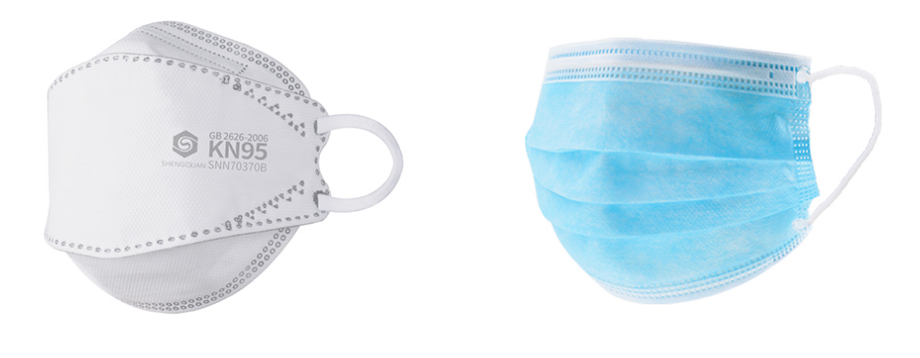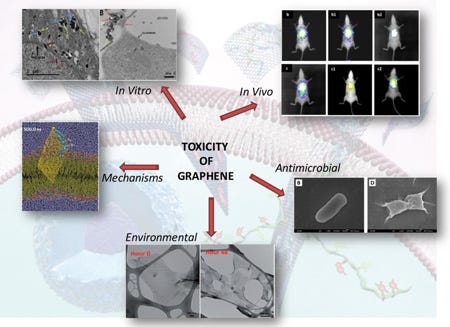GRAPHENE-BASED FRAUD
So, normally at work, if you are exposed to graphene, you would call it an occupational exposure and wear a mask NOT to inhale it. https://pubs.rsc.org/en/content/articlelanding/2018/NR/C8NR04950E Occupational exposure to graphene-based nanomaterials: risk assessment - Nanoscale (RSC Publishing)
But here we are FORCED to wear graphene-based masks, take graphene-based tests and inject graphene-based vaccines.
https://www.grapheneuses.org/graphene-masks/
http://web.archive.org/web/20200804113846/https://www.sqnewmaterials.com/
Some time ago I had an interesting conversation with a doctor working in the Covid ward. He observed cardiolipin damage in his patients.
Here is the explanation:
https://www.ncbi.nlm.nih.gov/labs/pmc/articles/PMC5039077/ (https://www.ncbi.nlm.nih.gov/pmc/articles/PMC5039077/pdf/nihms783634.pdf)
The main mechanism of graphene toxicity is associated with the generation of
intracellular reactive oxygen species that cause damage to proteins and DNA leading to cell death via apoptotic or necrotic pathways.
Studies have elucidated two mechanism of graphene mediated ROS damage:
(1) Upon cellular internalization, GO interferes with the electron transport system, induces overproduction of H2O2 and hydroxyl radicals.
This leads to the oxidization of cardiolipin and the release and translocation of hemoprotein from mitochondrial inner membrane to the cytoplasm.
This triggers release of cytochrome c complex which induces calcium release from endoplasmic reticulum and activates caspase 9 which in turn activates caspase 3 and 7 leading to cell death.
(2) GO induces the activation of MAPK (JNK, ERK) and TGF- β signaling pathways that lead to activation of Bcl-2 proteins which in turn activate mitochondria-induced apoptosis.
In addition to ROS induced cell death, GO may also lead to the activation of toll-like receptors and induce autophagy via inflammatory pathways.
Post internalization; graphene may induce DNA cleavage due to interactions such as pi-pi stacking, hydrophobicity, and electrostatic interactions. Singh et. al. have shown that surface charge distribution on graphene sheets plays an important role in the activation of src kinases and release of calcium eventually leading to platelet aggregation.
Several studies have reported that extremely sharp edges of graphene lead to membrane destabilization and loss of cell integrity by direct contact.
Reactive oxidation species mediated cell damage has been postulated as a primary cytotoxicity mechanism of graphene.
https://www.nature.com/articles/am20137#MOESM2 Biodistribution and pulmonary toxicity of intratracheally instilled graphene oxide in mice
Abstract
Graphene and its derivatives (for example, nanoscale graphene oxide (NGO) have emerged as extremely attractive nanomaterials for a wide range of applications, including diagnostics and therapeutics. In this work, we present a systematic study on the in vivo distribution and pulmonary toxicity of NGO for up to 3 months after exposure. Radioisotope tracing and morphological observation demonstrated that intratracheally instilled NGO was mainly retained in the lung.
NGO could result in acute lung injury (ALI) and chronic pulmonary fibrosis.
Such NGO-induced ALI was related to oxidative stress and could effectively be relieved with dexamethasone treatment. In addition, we found that the biodistribution of 125I-NGO varied greatly from that of 125I ions, hence it is possible that nanoparticulates could deliver
radioactive isotopes deep into the lung, which might settle in numerous ‘hot spots’ that could result in mutations and cancers,
raising environmental concerns about the large-scale production of graphene oxide.
The lung is the primary organ invaded by nanomaterials because of the communication of this organ with the outside atmosphere through the respiratory tract. In addition, nanoparticles (<100 nm) have previously been found to deposit mainly in the lungs.
Overall, NGO (nanoscale graphene oxide) resulted in acute lung injury (ALI), a clinical syndrome characterized by an excessive inflammatory response to both pulmonary and extrapulmonary stimuli that ultimately leads to a disruption of alveolar–capillary integrity with severe consequences for pulmonary gas exchange.
Given that NGO caused ALI at 24 h post exposure, we examined the time-dependent pulmonary responses induced by NGO. LDH and ALP activities were elevated at 24 h and then decreased (Figures 3a and b), suggesting that NGO induces early severe cell damage. The peaks of BAL fluid total protein, lung wet/dry weight ratio and BAL fluid differential cell counts occurred at 48 h, suggesting that this is the time point of the most severe disruption of the alveolar–capillary interface, lung edema and neutrophil infiltration. Moreover, the diffuse lung edema with protein-rich fluid, extensive hemorrhage and significant changes in alveolar architecture were clearly observed 48 h after instillation. These results indicate that NGO-induced ALI is progressive; it exhibits its greatest severity at 48 h and then is alleviated. Furthermore, the fibroproliferation and organization of lung tissue at 1 week indicates the emergence of lung fibrosis.
Because the inflammatory responses caused by nanomaterials are often associated with oxidative stress, we examined the degree of oxidative stress in the lung by measuring the levels of two antioxidants, superoxide dismutase (SOD) and glutathione peroxidase (GSH-PX). We observed a dosage-dependent decrease in SOD and GSH-PX activities in the lung tissue. In addition, the SOD and GSH-PX activities were progressively reduced after the exposure to NGO, reaching a minimum at 48 h, followed by an elevation until 1 week. These data suggest that oxidative stress has a significant role in NGO-induced ALI.
By examining the in vivo biodistribution and the acute and chronic pulmonary toxicity of intratracheally instilled NGO in the lungs of mice, we demonstrated that NGO was mainly retained in the lung after intratracheal instillation and, subsequently, was slowly cleared from the lung.
NGO was still present in the lung at 3 months.
NGO caused dosage-dependent ALI characterized mainly by cell injury, lung edema and neutrophil infiltration.
Because of their small sizes and high ratios of surface area to mass, carbon-based nanoparticulates are highly adsorptive to toxic substances, including radioactive species, which has attracted significant recent concern.
Given that the biodistribution of 125I-NGO varies greatly from that of 125I ions, it is possible that
nanoparticulates can deliver radioactive isotopes deep into the lungs.
These nanocarriers may also alter the biodistribution of the radioactive isotopes, settling in numerous ‘hot spots’ that can result in mutations and cancers.
https://www.hindawi.com/journals/bmri/2021/5518999/ Synthesis and Toxicity of Graphene Oxide Nanoparticles: A Literature Review of In Vitro and In Vivo Studies
Introduction
Nanoparticles are widely used in electronics, aeronautics, energy, agriculture, cosmetics, medicine, textile production, and many other fields. They are currently used to administer drugs, proteins, genes,
vaccines,
polypeptides, and nucleic acids.
Graphene is characterized by the diversity of its physicochemical properties, including thermal property, electrical conductivity, mechanical strength, and transparency.
In recent years, graphene has been exploited in the medical field, particularly for DNA sequencing, the development of biosensors, and cell differentiation and growth.
As graphene is insoluble in water, its applications are limited to passive platforms for detection and cell work. Its functional derivative GO has unique properties that make it more effective for biomedical applications. It is characterized by its ability to disperse in many solvents, facilitating its handling.
As applications increase, exposure to GO increases across populations. These include exposures during nanomaterial manufacturing and biomedical treatment.
GO is involved in many applications, but there is one main factor limiting “its toxicity” limiting its use.
Researchers are often faced with the problem of balancing the positive therapeutic effects of GO with the side effects associated with its toxicity.
Toxicity in the Respiratory System
Li et al. found that intratracheally instilled GO nanosheets can be retained in the lungs. This exposure resulted in acute lung injury and chronic pulmonary fibrosis. They found that these GO-induced acute lung lesions are related to oxidative stress. Also, histopathological examination revealed that GO induced fibroproliferation and organization of lung tissue in the acute phase.
However, intravenous administration of GO caused massive pulmonary thromboembolism in mice.
The prothrombotic character of GO was dependent on the distribution of the surface charge. Direct administration of GO into the lungs of mice resulted in severe and chronic lung damage. These GO nanosheets disrupted the alveolar-capillary barrier, allowing inflammatory cells to infiltrate the lungs and stimulate the release of proinflammatory cytokines.
Toxicity in the Digestive System
Toxicity in the Urinary System
Toxicity in the Central Nervous System
Toxicity in Reproductive and Development System
Genotoxicity
Toxicity Mechanisms
Interactions of GO with Cell Membranes
Studies have shown that the interaction between GO and cell membranes is one of the main causes of GO cytotoxicity. Direct contact of the GO with the cells damaged the outer membrane of E. coli bacteria and caused the release of intracellular components, leading to cell death. Another study showed that the cytotoxicity of GO is due to direct interactions between the cell membrane and the GO nanosheets that result in physical damage to the cell membrane. Besides, incubation of GO with bovine fetal serum (FBS) reduced the observed damage because of the extremely high protein adsorption capacity of GO. In addition, it has been shown that the interaction of the GO with the lipid membrane is the mechanism for the destructive extraction of membrane lipids. Once GO penetrates the cell, it can destroy high amounts of lipid membrane phospholipids and inducing cell membrane degradation.
Oxidative Stress
The toxicity of GO nanosheets is often manifested by the production of reactive oxygen species (ROS), leading to oxidative stress characterized by an imbalance between free radicals and antioxidants. ROSs act as secondary messengers in many intracellular signaling cascades and lead to cellular macromolecular damage, such as degradation of membrane lipids, DNA fragmentation, protein denaturation, and mitochondrial dysfunctions.
Therefore, the cytotoxic effect of GO on human lung fibroblast (HLF) cells could be due to the oxidative stress that caused apoptosis and DNA damage after exposure of these cells to GO.
Although GO is useful for many applications, there is still a risk related to its “toxicity,” limiting its uses. Studies conducted so far indicate that the toxicity of GO could depend on its size, synthesis methods, route of administration, and exposure time.
ROS-mediated cellular damage has been postulated as a primary mechanism of GO cytotoxicity.
In general, available GO toxicity studies are mainly limited to evaluating acute toxicity, while chronic toxicological studies lack.
The people behind it know about the damage it causes. This is a deliberate action.
Effect of graphene on growth and development of (A–C) seedling and (D–F) cotyledons and root systems of cabbage, tomato and red spinach after exposure to 500–2000 mg/L concentration for 20 and 4 days, respectively. A dose-dependent reduction in the plant growth and biomass production is observed.






Two things:
1. I am not the only one who understand it is intentional:
https://rumble.com/v23y848-bret-weinstein-questions-the-true-motives-behind-the-covid-vaccine-campaign.html
2 This is how GRAPHENE-BASED FRAUD post was flagged now:
Warning: suspected fake website
Close
This link leads to a website that might be trying to steal your information, such as passwords and credit card details.
So, you know we hit the nail on the head.
"But here we are FORCED to wear graphene-based masks."
No one has forced me to wear a mask, and never will.
The reason this is happening is because evil beings want to KILL YOU and ME, and indeed ALL LIFE.
Sure, none of it makes sense to a reasonably kind and easygoing person, but that doesn't make one jot or tittle of a difference.
I have hope that some of us trying to maintain a semblance of sanity, can learn to speak strong and loud and clear that we will not comply, nor go down with a muzzle upon our faces.
Stand up, and do not die on your knees.
This may be what the price of truth and salvation is, for those that can face the music. Strength to Endure and Triumph!